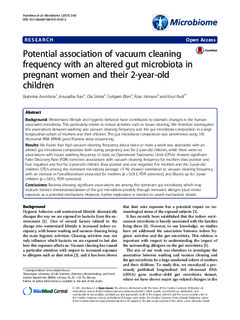| dc.contributor.author | Avershina, E. | |
| dc.contributor.author | Ravi, Anuradha | |
| dc.contributor.author | Storrø, Ola | |
| dc.contributor.author | Øien, Torbjørn | |
| dc.contributor.author | Johnsen, Roar | |
| dc.contributor.author | Rudi, Knut | |
| dc.date.accessioned | 2016-01-14T14:45:12Z | |
| dc.date.accessioned | 2016-01-25T14:53:31Z | |
| dc.date.available | 2016-01-14T14:45:12Z | |
| dc.date.available | 2016-01-25T14:53:31Z | |
| dc.date.issued | 2015 | |
| dc.identifier.citation | Microbiome 2015, 3(65) | nb_NO |
| dc.identifier.issn | 2049-2618 | |
| dc.identifier.uri | http://hdl.handle.net/11250/2374801 | |
| dc.description.abstract | Background:
Westernized lifestyle and hygienic behavior have contributed to dramatic changes in the human-associated microbiota. This particularly relates to indoor activities such as house cleaning. We therefore investigated the associations between washing and vacuum cleaning frequency and the gut microbiota composition in a large longitudinal cohort of mothers and their children. The gut microbiota composition was determined using 16S ribosomal RNA (rRNA) gene Illumina deep sequencing.
Results:
We found that high vacuum cleaning frequency about twice or more a week was associated with an altered gut microbiota composition both during pregnancy and for 2-year-old children, while there were no associations with house washing frequency. In total, six Operational Taxonomic Units (OTUs) showed significant False Discovery Rate (FDR) corrected associations with vacuum cleaning frequency for mothers (two positive and four negative) and five for 2-year-old children (four positive and one negative). For mothers and the 2-year-old children, OTUs among the dominant microbiota (average >5 %) showed correlation to vacuum cleaning frequency, with an increase in Faecalibacterium prausnitzii for mothers (p = 0.013, FDR corrected), and Blautia sp. for 2-year children (p = 0.012, FDR corrected).
Conclusions:
Bacteria showing significant associations are among the dominant gut microbiota, which may indicate indirect immunomodulation of the gut microbiota possibly through increased allergen (dust mites) exposure as a potential mechanism. However, further exploration is needed to unveil mechanistic details. | nb_NO |
| dc.language.iso | eng | nb_NO |
| dc.publisher | BioMed Central | nb_NO |
| dc.title | Potential association of vacuum cleaning frequency with an altered gut microbiota in pregnant women and their 2-year-old children | nb_NO |
| dc.type | Journal article | nb_NO |
| dc.type | Peer reviewed | en_GB |
| dc.date.updated | 2016-01-14T14:45:12Z | |
| dc.source.volume | 3 | nb_NO |
| dc.source.journal | Microbiome | nb_NO |
| dc.source.issue | 65 | nb_NO |
| dc.identifier.doi | 10.1186/s40168-015-0125-2 | |
| dc.identifier.cristin | 1304132 | |
| dc.description.localcode | © 2015 Avershina et al. Open Access This article is distributed under the terms of the Creative Commons Attribution 4.0 International License (http://creativecommons.org/licenses/by/4.0/), which permits unrestricted use, distribution, and reproduction in any medium, provided you give appropriate credit to the original author(s) and the source, provide a link to the Creative Commons license, and indicate if changes were made. The Creative Commons Public Domain Dedication waiver (http://creativecommons.org/publicdomain/zero/1.0/) applies to the data made available in this article, unless otherwise stated. | nb_NO |
